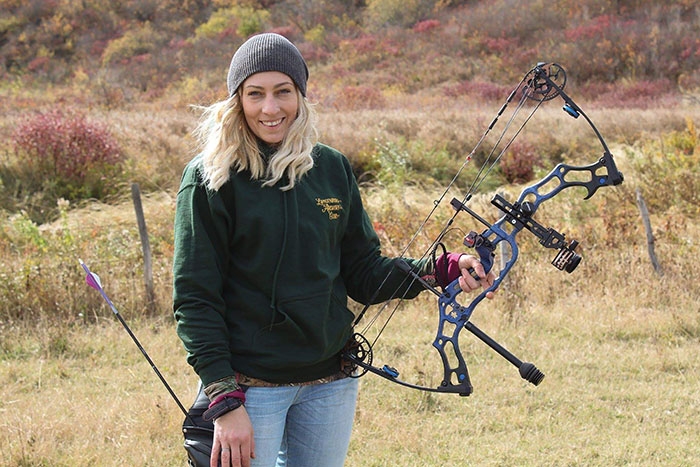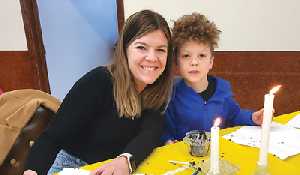Lacey Moore - Second time gold medalist
May 8, 2019, 10:05 am
Donna Beutler


Spy Hill-area resident Lacey Moore has taken her love of archery to the national level where she has won gold two years in a row in women’s compound archery.
Moore, 33, is a contract and risk lawyer who spends her off-time practising with her compound bow and competing in various archery competitions around Saskatchewan.
Moore grew up in the Spy Hill area where she really enjoyed hunting. She spent several years in the Ottawa area before moving ‘back home’ about four years ago.
As a hunter, Moore really wanted to extend the season, and by taking up bow hunting, she could do exactly that. Moore generally hunts deer and turkey with her bow.
“It keeps me active,” Moore said of her chosen sport. It’s one that sees her on the road to various competitions for much of the year from January through September.
“I started about 10 years ago and did it as hunting and then progressed from hunting to wanting to do something all year around. Competitively I’ve been shooting the past three years.
“First I started to do it just hunting because the hunting season was longer and it allowed me to sit in a tree stand and I did a lot of schoolwork, reading my text books. It was a way to just to be away—it’s quiet and peaceful.
“And then competitively, the indoor allowed me to do it through the winter. I’ve always been really busy with travel with work. It’s a solo sport so you don’t have to rely on a team, so it was something to get me through the winter. It’s a very relaxing sport. It’s a nice way to relax.
“From January to April, I compete at indoor competitions and from May to the end of September, I compete at outdoor ones,” Moore said of the one- and two-day weekend competitions she attends.
Moore competes in the Compound Fixed Pin category. Other compound bow categories include an open division and a hunter division.
“Indoor competitions have a very controlled environment,” Moore said, “and the lighting in buildings like arenas can throw you off.” As for the outdoor competitions, the wind can be a challenge.
“Last year at provincials in Regina, there were 75-kilometre-an-hour winds,” Moore said.
“Outdoor competitions are more fun and they often include hills and other challenges.”
Moore said indoor competitions have targets set up on pallets in order to make it as challenging as possible.
Moore explained the Compound Fixed Pin category, describing the modern archery bow as “a bow that uses a levering system, usually of cables and pulleys, to bend the limbs.”
Moore says the fixed pin sights are fixed in place and cannot be moved during competition. This particular class also allows a levelling device placed on the sight and a stabilizer to help counterbalance the bow weight.
Moore was in Brandon, Manitoba April 27-28 where she competed in the 15th Annual Indoor 3D Archery Canadian Championships hosted by the Carberry Archery Club.
According to Moore, there were 200 archers “taking aim at a chance of taking home a medal.” At the end of the championships, Moore said, “Only 30 new national titlists were crowned.”
Only four of the 30 archers at the Brandon competition successfully defended their national titles from 2018, Moore being one of them.
Moore says she didn’t really think about the fact that she had won the national title two years in a row.
“I didn’t really think about it that way. It’s humbling, but it was more that this time when I won it, it was more of a challenge,” she says. “Last year it was easier to win, this year I only earned gold by two points, it was a very close race. The challenge was awesome, and the equipment I used to shoot—I could have shot in a different class, but I chose to stay in the same one as I did last year. I chose to stay in it just to challenge myself, to shoot against some better archers with a little bit more technical equipment than I shoot with. It’s more of a challenge and it makes it more exciting.
“You shoot three rounds with the same group of people and they were a great group of women to shoot with. It could have gone either way.”
Moore says archers who shoot at the national level generally know what they are doing already, but that some coaching can be helpful leading up to a national event. Moore takes advantage of some coaching to help her get ready.
“Some people get coaches. I will train with a coach a few times coming up to the competition just to make sure my form is right,” she says. “Usually people at that level know the forms, know how they have to stand, so they are past the point where they get a lot of direction. But it’s still really nice to have the support of a coach.
“Me, I just try to squeeze it in when I can. If I’m home I will go to Moose Jaw, and my person that I use is called Tyler Moore. He’s really great at helping me with making sure my bow is in tune and making sure I’m doing the right postures and breathing.
“My dad is also my biggest supporter and coach. He comes with me to every competition—Grant Moore is his name. He’s really good. He’ll stand there and pick apart how I’m standing or breathing, or he calms me down when I need to be calmed down. He comes to every competition that I go in.”
Moore says the sport of 3D archery has been a rapidly growing sport across Canada.
“3D archery means shooting at life-like three dimensional animal-shaped targets,” Moore explained.
“The targets are placed in dynamic settings and at varying distances. It is a fun and challenging sport in which competitors must gauge the distance to the target and adjust their aim to hit the centre of the scoring rings on the target with the goal to achieve the highest possible score for the course.”
And with the challenge of hitting those targets at random locations of between 10 and 50 yards, Moore will keep practising her skill and will keep on competing at provincial and national levels.
Moore is also a volunteer and a coach at the Langenburg Archery Club—something that she and four other people got started about a year and a half ago.
She says there is a ton of interest from kids in the sport—and they aren’t always the same kind of kids who are into team sports like hockey that require a lot of travel time.
“The first time we ran a course to teach kids, we had 30-some kids and we had to turn away other ones. It was kids who a lot of them weren’t in other things,” she says. “It’s calming, it’s relaxing, it shows them focus, and can be dangerous, so it requires a lot of obedience as well.”



































